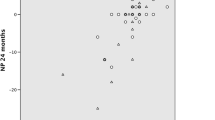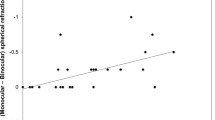Abstract
Background
To compare the accommodative amplitude (AA), facility (AF), and lag between dominant and non-dominant eyes.
Methods
Seventy students [mean (SD) age: 21.2 (1.7) years, range 18–25] from Zahedan University of Medical Sciences were selected. Retinoscopy and subjective refraction was used to determine the refractive error. The hole-in-the card method was used to determine eye dominance. The accommodative amplitude (AA) was measured in the dominant and non-dominant eye using the push-up method, and accommodative facility (AF) using ±2.00 dioptre flipper lenses at 40 cm. Accommodative lag was determined using monocular estimate method (MEM) retinoscopy at 40 cm.
Results
The right eye was dominant in 53 subjects (75.7 %). There was no significant difference in refractive error (sphere, cylinder, and spherical equivalent) between dominant and non-dominant eyes. The mean (SD) for the AA, AF, and lag in dominant eyes was 12.48 (2.56) dioptres, 12.45 (4.83) cycles per minute, and 0.80 (0.27) dioptres respectively. The mean (SD) for the AA, AF, and lag in non-dominant eyes was 12.16 (2.37) dioptres, 12.20 (4.88) cycles per minute, and 0.83 (0.28) dioptres respectively. The mean (SD) difference in AA, AF, and lag between dominant and non dominant eyes was 0.32 (0.75) dioptres (P = 0.001), 0.25 (1.05) cycles per minute (P = 0.04), and −0.02 (0.11) dioptres (P = 0.10) respectively. The AA and AF was statistically better (P < 0.05) in the dominant eye group than in the non-dominant eye group. These data provided little evidence of any difference in the accommodative lag between dominant and non-dominant eyes (P > 0.05).
Conclusion
The right eye was dominant in 76 % of subjects. Superior AA and AF was found in the dominant eye as determined by hole-in-the card method in young healthy adults, although these differences are perhaps not of clinical significance (<0.50 dioptres and <2 cycles per minute).

Similar content being viewed by others
References
Chia A, Jaurigue A, Gazzard G, Wang Y, Tan D, Stone RA, Saw SM (2007) Ocular dominance, laterality, and refraction in Singaporean children. Invest Ophthalmol Vis Sci 48(8):3533–3536
Li J, Lam CS, Yu M, Hess RF, Chan LY, Maehara G, Woo GC, Thompson B (2010) Quantifying sensory eye dominance in the normal visual system: a new technique and insights into variation across traditional tests. Invest Ophthalmol Vis Sci 51(12):6875–6881
Yang E, Blake R, McDonald JE 2nd (2010) A new interocular suppression technique for measuring sensory eye dominance. Invest Ophthalmol Vis Sci 51(1):588–593
Steinman SB, Steinman BA, Garza RP (2000) Foundations of binocular vision: a clinical perspective. McGraw–Hill, New York, pp 24–27,56–57
Griffin J, Grisham D (2002) Binocular anomalies: diagnosis and vision therapy, 4th edn. Butterworth–Heinemann, Boston, pp 42–48
Eser I, Durrie DS, Schwendeman F, Stahl JE (2008) Association between ocular dominance and refraction. J Refract Surg 24(7):685–689
Garcia-Gonzalez M, Teus MA, Hernandez-Verdejo JL (2010) Visual outcomes of LASIK-induced monovision in myopic patients with presbyopia. Am J Ophthalmol 150(3):381–386
Chen W, Meng Q, Ye H, Liu Y (2011) Reading ability and stereoacuity with combined implantation of refractive and diffractive multifocal intraocular lenses. Acta Ophthalmol 89(4):376–381
Benjamin WJ (2006) Borish’s clinical refraction, vol 92, 2nd edn. Butterworth–Heinemann, Boston, p 1040
Hoffman LG, Rouse M (1980) Referral recommendations for binocular function and/or developmental perceptual deficiencies. J Am Optom Assoc 51(2):119–126
Eskridge JB, Amos JF, Bartlett JD (1991) Clinical procedures in optometry. J.B. Lippincott, Philadelphia, pp 687, 691
Scheiman M, Wick B (2008) Clinical management of binocular vision: heterophoric, accommodative and eye movement disorders, 3rd edn. Lippincott Williams & Wilkins, Philadelphia, p 350
Fong DS (1997) Is myopia related to amplitude of accommodation? Am J Ophthalmol 123(3):416–418
Firth AY (1992) Adie syndrome: evidence for refractive error and accommodative asymmetry as the cause of amblyopia. Am J Ophthalmol 128(1):118–119
Handa T, Mukuno K, Uozato H, Niida T, Shoji N, Shimizu K (2004) Effects of dominant and nondominant eyes in binocular rivalry. Optom Vis Sci 81(5):377–383
Cho KJ, Kim SY, Yang SW (2009) The refractive errors of dominant and non-dominant eyes. J Korean Ophthalmol Soc 50(2):275–279
Cheng CY, Yen MY, Lin HY, Hsia WW, Hsu WM (2004) Association of ocular dominance and anisometropic myopia. Invest Ophthalmol Vis Sci 45(8):2856–2860
Chen J, Wang ZZ, Yu XP, Wang YW (2009) Accommodative function in adolescent hyperopic anisometropes. Chin J Optom Ophthalmol 4(11):254–256
Linke SJ, Baviera J, Munzer G, Steinberg J, Richard G, Katz T (2011) Association between ocular dominance and spherical/astigmatic anisometropia, age, and sex: analysis of 10,264 myopic individuals. Invest Ophthalmol Vis Sci 52(12):9166–9173
Linke SJ, Baviera J, Richard G, Katz T (2012) Association between ocular dominance and spherical/astigmatic anisometropia, age and sex: analysis of 1274 hyperopic individuals. Invest Ophthalmol Vis Sci 53(9):5362–5369
Koo BS, Cho YA (1996) The relationship of dominant eye, dominant hand, and deviated eye in strabismus. J Korean Ophthalmol Soc 37(8):1277–1282
Domenech B, Mas D, Illueca C (2010) Influence of ocular dominance in the variability of the eye’s anterior segment measurements. Opt Int J Light Electron 121(24):2221–2223
Kawata H, Ohtsuka K (2001) Dynamic asymmetries in convergence eye movements under natural viewing conditions. Jpn J Ophthalmol 45(5):437–444
Adamek B, Karczewicz D (2006) The dependence of the range of fusion on some selected functions of the visual system. Part II: Accommodation and dominance. Klin Oczna 108(4–6):167–169
Yang HK, Hwang JM (2011) Decreased accommodative response in the nondominant eye of patients with intermittent exotropia. Am J Ophthalmol 151(1):71–76
García A, Cacho P (2002) MEM and Nott dynamic retinoscopy in patients with disorders of vergence and accommodation. Ophthalmic Physiol Opt 22(3):214–220
Correction of Myopia Evaluation Trial 2 Study Group for the Pediatric Eye Disease Investigator Group (2009) Accommodative lag by autorefraction and two dynamic retinoscopy methods. Optom Vis Sci 86(3):233–243
Grosvenor T (2007) Primary care optometry, 5th edn. Butterworth–Heinemann, Boston, pp 285–286
McAlinden C, Khadka J, Pesudovs K (2011) Statistical methods for conducting agreement (comparison of clinical tests) and precision (repeatability or reproducibility) studies in optometry and ophthalmology. Ophthalmic Physiol Opt 31(4):330–338
Ibi K (1997) Characteristics of dynamic accommodation responses: comparison between the dominant and non-dominant eyes. Ophthalmic Physiol Opt 17:44–54
Mansour AM, Sbeity ZM, Kassak KM (2003) Hand dominance, eye laterality and refraction. Acta Ophthalmol Scand 81(1):82–83
Fujimura F, Handa T, Uozato H, Shoji N, Shimizu K (2007) Effects of ocular dominance on accommodation. J Eye 24(1):121–124
Acknowledgments
The authors would like to thank participants who made this study possible.
Conflict of Interest
No financial interest to any material or method mentioned.
Author information
Authors and Affiliations
Corresponding author
Rights and permissions
About this article
Cite this article
Momeni-Moghaddam, H., McAlinden, C., Azimi, A. et al. Comparing accommodative function between the dominant and non-dominant eye. Graefes Arch Clin Exp Ophthalmol 252, 509–514 (2014). https://doi.org/10.1007/s00417-013-2480-7
Received:
Revised:
Accepted:
Published:
Issue Date:
DOI: https://doi.org/10.1007/s00417-013-2480-7




